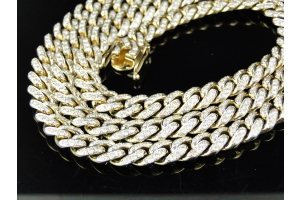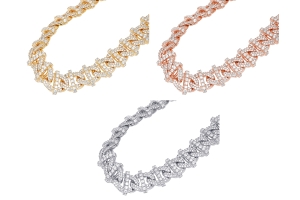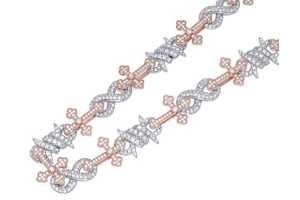What Is the Meaning of Gold Karat?

Karat is a measure of gold purity. If an alloy has 1 karat gold content, this means that 1/24th of it is pure gold.To figure out what fraction of the material in a gold chain is pure gold, divide its karat by 24. For example, a 10-karat chain contains 41.7% gold (10 karats divided by 24 times 100).
What Are 14K Gold Chains Made Of?
14-karat gold chains are made of 14 parts gold and 10 parts other metals. In terms of percentage, a 14K gold chain contains 58.3% pure gold. The metals usually mixed with gold in 14-karat alloys are copper, zinc, silver, palladium, and nickel.
What Is the Composition of 18K Gold Chains?
18-karat gold chains contain 6 parts nongold metals and 18 parts gold. Therefore, such a chain contains 75% gold. The metals used in an 18K gold alloy are more or less the same as those used in 14K gold.
14K vs. 18K Gold Chains: What Are the Differences?
14-karat gold chains and 18-karat gold chains differ mainly in durability, price, color, and the likelihood to cause an allergic reaction to nickel.
Durability
Gold is soft, and gold alloys with lower gold content tend to be harder than alloys containing a higher percentage of pure gold. So, you can expect a 14K gold chain to be harder than an 18K chain, which will be likely to bend more easily. Because they are not as soft as 18K gold chains, 14K chains wear out more slowly and are a better choice for jewelry that you will wear every day.18-karat gold chains, on the other hand, will show signs of wear more quickly and are a better choice if you need jewelry that you will wear less often.
Price per Gram
Because of its lower gold content, a 14K chain will usually be cheaper than an 18K one. Here we are not discussing absolute prices but rather prices per gram or ounce.On such a relative basis, 18-karat chains are more expensive, and for the same money, you will likely be able to buy a bigger 14K chain.
Nickel Content and Allergies
Since a higher percentage of 14-karat gold contains other metals (compared with 18-karat gold), 14K chains that contain nickel are more likely to cause an allergic reaction in people with such an allergy. 18K gold chains are less likely to cause a rash due to the presence of nickel, but people differ in their sensitivity to this metal, and some may need jewelry that is 20K or even 22K to feel comfortable. So, if you are sensitive to nickel, avoid low-karat jewelry that contains this metal, or look specifically for gold that is nickel free.
Color

18-karat gold alloys contain more gold, and this is why their color tends to be yellower. Lower-karat gold alloys, on the other hand, look less like pure gold. So, an 18K gold chain is likely to have a better color, which will look more “gold-like.” In comparison, you might assume that a 14K gold chain will have a less intense gold color. In reality, you might not be able to spot any visible difference between an 18K and a 14K gold chain, and you might have to look really hard to tell one from the other. This is why you should see the chains you are considering for yourself and decide whether there is really a noticeable difference in color.
It is advised to take into account all four factors we outlined above and weight each one according to how important it is to you.
14K vs. 10K Gold Chains: What Are the Differences?
If you are looking to buy a gold necklace, you might find yourself trying to decide between a 10-karat and a 14-karat chain. But how should you compare them? Read this article to learn more about the differences between 10K and 14K gold necklaces.
Gold Content: Which Has Higher Purity?
The percentage of gold content is one of the main differences between 10K and 14K gold necklaces.
10-karat gold contains 10 parts pure gold and 14 parts additional metals such as zinc, palladium, copper, tin, etc. 14-karat gold, in contrast, has 10 parts other metals for every 14 parts gold. As you can see, a 14K gold necklace has higher purity, at 58.3% gold content, compared with a 10K chain, which contains 41.7% pure gold.
Price per Gram/Ounce: Which Is Cheaper?
Because it contains more gold per unit of weight, a 14K gold chain will be more expensive on a per-gram/per-ounce basis. If you want a more affordable gold necklace, pick a 10-karat one, which will be cheaper due to its lower gold content.
Durability: Which Will Last Longer?
Although 10K gold is less pure, the higher proportion of other metals actually makes it harder. This is why necklaces made of 10K gold are more durable and last longer than 14K gold ones. 14K gold is less durable in comparison – it contains more gold, which is actually a very soft metal. For that reason, 14-karat gold chains scratch more easily and wear down faster than 10-karat ones.It should be noted, however, that 14K gold is still pretty durable compared with 18K or 20K gold.
Gold Tone: Which Has a Better Color?
It can be argued that a 14K gold necklace will have a color that is more like that of real gold, as the alloy contains more of the metal. Some people find that 10K necklaces look whiter and that their yellow tone is not as rich. You should decide for yourself whether two particular chains, one 10 karats and the other 14 karats, really look different in terms of color.
The tone of a gold alloy depends not only on the percentage of gold in it but also on the type and amount of the other metals mixed in. That’s why you could see 10K necklaces that have a warmer color and other of the same karat that look whiter.
Tendency to Cause Skin Irritation
If low-karat gold tends to irritate your skin and give you a rash, perhaps wearing a 10K gold necklace is not the best idea.Skin irritation in such cases is usually caused by the presence of nickel in the gold alloy, and low-purity alloys that contain this metal simply have it in higher concentration. A 14-karat gold necklace would be a better choice if you want to avoid an allergic reaction to nickel.
Keep in mind that if you are too sensitive to the metal, you might need an even higher-karat gold chain, or a nickel-free one.
How to Choose: 10-Karat vs. 14-Karat Gold Necklaces
- Pick a 10K gold necklace if you want a piece that is more durable and cheaper at the same time, and if you don’t care that much about how rich the yellow color of the gold will be.
- Choose a 14K gold necklace if color is more important to you, and if you don’t mind paying a higher price for a piece that contains more gold but is likely to be slightly softer in comparison with 10K gold.
- What Determines the Value of a Gold Necklace?
- The value of a gold necklace depends on a variety of factors. A new necklace will sell for a price that reflects its design, brand, structure, materials, among other characteristics.
- If you are going to sell your 14K necklace for scrap gold, however, its value will be determined based on one major factor – the gold content of the piece.
How to Find Out the Value of the Gold in Your Jewelry
To figure out the value of a piece of gold jewelry, you need to determine how much the pure gold in it is worth, and this value depends on the precious metal’s price on the market.The market price of gold changes every day, and you can look it up on a variety of websites (such as CNN).Keep in mind that the gold price quoted on commodity exchanges does not reflect accurately the money you could get for your jewelry if you decide to sell it.To get a better estimate of the value of your gold, you can reduce its current market price by about 20%-30%.
The result will be the approximate price you can expect gold dealers to pay – most of them will usually offer you about 80% of the market price of gold per gram.

How to Determine the Amount of Pure Gold in a 14K Necklace
Knowing how much money you can get for the pure gold in your jewelry per unit of weight, now you need to find the answer to another important question: How much gold does your 14K necklace actually contain?
How Much Pure Gold Does 14K Jewelry Contain?
14 karats gold purity implies that if the total weight of the gold alloy is assumed to be 24 parts, 14 parts of it is pure gold and 10 parts is other metals. From the above, it follows that the pure gold in your 14K gold necklace is 58.3% (14 divided by 24).
Determining the Total Weight of Your Gold Necklace
To find the absolute amount of pure gold in your necklace, you will need to weigh it. Before you do that, don’t forget to remove any stones so as not to artificially inflate the calculated weight of the gold alloy in the piece. Weigh your necklace on a scale and record the weight in grams or ounces. If you need to convert the weight into troy ounces, remember that 1 gram is equal to 0.03215 troy ounces, and 1 ounce equals 0.91146 troy ounces.
Some jewelers also use pennyweights as units of measurement, so you should know that 1 troy ounce is equal to 20 pennyweights (abbreviated as “dwt”).
Determining the Weight of Pure Gold in a 14K Necklace
After you’ve determined the total weight of your 14K necklace, you can find out the weight of the pure gold in it. Simply multiply the necklace’s weight by its gold content percentage, which we already calculated to be 58.3%. For example, if you have determined that your necklace weighs 8 grams, then the pure gold in it will be 58.3% of that number or about 4.7 grams.
Choosing Karat for Your Gold Chain

When deciding what karat your gold chain should be, keep in mind that the purer the gold, the softer and less durable it will be. So, if you are going to wear your chain every day, you might want to skip the 20Kt and 22Kt pieces, which will scratch more easily compared with 10Kt or 14Kt chains, which are harder since they contain a higher percentage of non-gold alloys.Click here to see an outstanding selection of gold chains.
Although low-karat gold is more durable, it is not recommended if you are allergic to nickel – many gold alloys contain this metal, and the lower the gold purity, the more nickel the piece may contain.
If you are concerned about having an allergic reaction, do not buy 10Kt gold (unless you are sure it is nickel free). Stick with 14Kt or 18Kt gold instead. (Please note that 14Kt gold may still cause an allergic reaction if you are really sensitive to nickel.)








